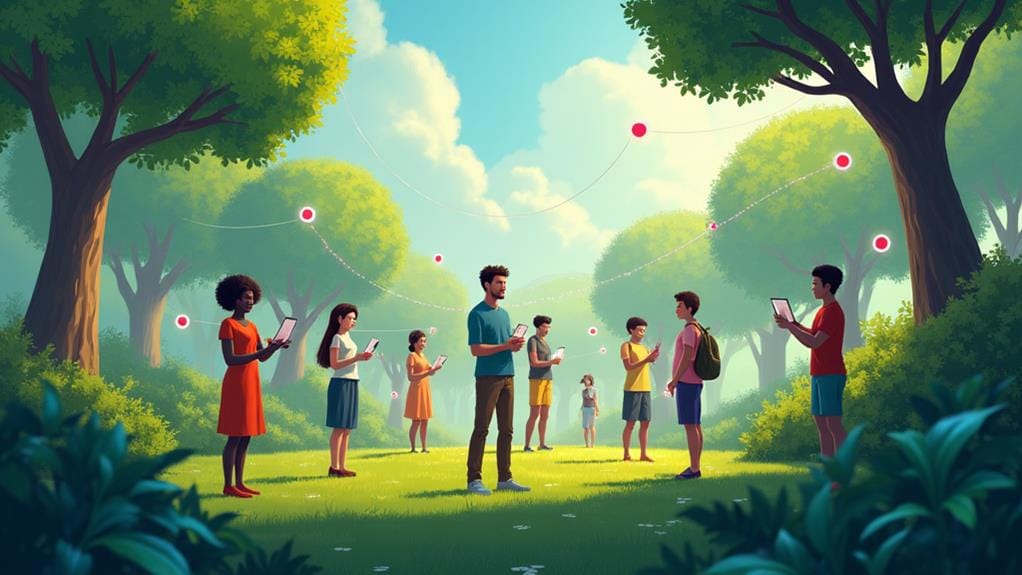

Estás cambiando tu estrategia de medios sociales de acumular seguidores a construir una comunidad de afiliados comprometidos y fieles. Este nuevo paradigma se centra en interacciones significativas y un importante retorno de la inversión. Para tener éxito, tendrá que crear contenidos que resuenen entre su público objetivo y fomenten las conexiones. Los micro y nanoinfluenciadores pueden ayudarle a crear relaciones auténticas y aumentar los índices de participación. A medida que se adapte a este nuevo panorama, descubrirá que métricas de compromiso con la comunidadcomo los comentarios y las comparticiones, son más valiosas que las métricas de vanidad. Al dar prioridad a la creación de comunidades, revelarás los secretos para impulsar el crecimiento real y la fidelidad, y eso es solo el principio.
Su estrategia de medios sociales debe cambiar de enfoque: de acumular seguidores a construir una comunidad.
El auge de plataformas descentralizadas de medios sociales y cambiando marketing de influencers[1] señal paisajística a cambio significativo en la forma de enfocar las redes sociales. Ya no se trata solo de acumular seguidores, sino de cultivar una comunidad que invierta en su marca.
Esta transformación coincide con la idea de que las estrategias de medios sociales pueden producir un enorme ROI social con una inversión mínima.
Este cambio tiene que ver con priorizar el compromiso por encima de las cifras. Se trata de crear interacciones y conexiones significativas entre los usuarios, en lugar de limitarse a transmitir su mensaje a una gran audiencia.
Los estudios demuestran que micro y nanoinfluenciadorescon sus seguidores, más pequeños pero más comprometidos, son cada vez más valiosos para las marcas que buscan crear esfuerzos de marketing centrados en la comunidad.
¿Cómo deben adaptarse las estrategias de las redes sociales al nuevo panorama? Debes centrarte en crear contenidos que resuenen entre tu público objetivo y fomenten conexiones significativas.
El cambio de paradigma en la dinámica de las redes sociales hace más hincapié en crear comunidad que en acumular seguidores. A medida que plataformas como Facebook[5]'s publicidad dirigida[2] y Instagram[6]La interacción con el público es ahora más esencial que nunca.
Para adaptarse eficazmente, considere las siguientes estrategias:

En estrategias de medios sociales hacia creación de comunidadesLa pregunta sigue siendo: ¿qué hace falta para crear conexiones auténticas con su público en Internet? La respuesta está en gobernanza comunitaria y interacciones significativas.
Las plataformas descentralizadas de medios sociales, como Mastodon y Bluesky, están abriendo camino al dar a los usuarios el control sobre sus datos e interacciones, fomentando un sentido de comunidad y propiedad compartida. Entendiendo preferencias del público y comportamientos, las marcas pueden crear contenido atractivo que despierte la curiosidad e invite a la interacción.
Cuando te centras en construir relaciones y confianza con tu audiencia, tienes más probabilidades de crear conexiones significativas. Por eso 90% de los profesionales del marketing reconocen marketing de influencers como eficaces para fomentar conexiones genuinas.
Los microinfluenciadores y los nanoinfluenciadores, en particular, tienen mayores índices de participación debido a sus comunidades muy unidas, lo que los convierte en socios ideales para establecer relaciones auténticas.
Hemos establecido que construir conexiones significativas con su público en línea requiere un cambio de enfoque, de acumular seguidores a crear un sentido de comunidad.
Para lograrlo, es necesario aplicar estrategias de participación comunitaria que dan prioridad a las relaciones sobre el mero número de seguidores. Al hacerlo, puedes conseguir hasta 18 veces más engagement que aquellos que se centran únicamente en aumentar su número de seguidores.
Incorporación de auténtico cliente[7] experiencias a través de contenidos generados por los usuarios puede mejorar en gran medida confianza y lealtad entre su público.
Esto es lo que puede hacer para fomentar la participación de la comunidad:

Las comunidades de nicho se han convertido en una fuerza motriz de las redes sociales, impulsadas por la creciente influencia de micro y nanoinfluenciadores que están redefiniendo la forma en que las marcas conectan con su público.
Estas personas influyentes se comprometen de forma más auténtica con sus seguidores, fomentando mayor confianza y lealtad en comparación con las personas influyentes tradicionales. Como resultado, más de 240 nuevos plataformas de marketing de influencers y agencias han surgido en sólo un año, atendiendo a segmentos de audiencia específicos.
Este cambio refleja un cambio más amplio en la dinámica de las redes sociales, donde las marcas dan prioridad a la creación de redes sociales. conexiones genuinas con grupos más pequeños y dedicados a acumular un gran número de seguidores.
Los profesionales inmobiliarios, por ejemplo, pueden utilizar las redes sociales publicidad[4] para llegar con eficacia a públicos especializados y fomentar los lazos comunitarios.
Medición éxito comunitario en las redes sociales requiere un cambio de enfoque de las métricas de vanidad, como el número de seguidores, a métricas más centradas en los resultados. indicadores significativos de compromiso. Debes mirar más allá del número de seguidores y centrarte en cómo interactúan con tu marca.
Si se centra en estas métricas, obtendrá una imagen más clara de la salud de su comunidad. Por ejemplo, un estudio reveló que las marcas con un alto grado de compromiso con la comunidad registran un aumento del 20-40% en retención de clientes.

Cambios más significativos en interacción en las redes sociales tienen algo en común: han pasado de centrarse únicamente en el número de seguidores a hacer hincapié en compromiso de la comunidad.
Es probable que note esta tendencia en el aumento de plataformas descentralizadas como Mastodon y Bluesky, que dan más control a los usuarios y promueven la gobernanza comunitaria. Este cambio permite conexiones auténticas entre los usuarios, alejándose del enfoque superficial de los números.
A medida que te involucres en las redes sociales, verás que se hace más hincapié en micro y nanoinfluenciadores que generan confianza y lealtad en comunidades especializadas.
Estas personas influyentes dan prioridad a conexiones personales sobre el mensaje tradicional de la marca, fomentando relaciones significativas con su audiencia. Para las marcas, esto significa centrarse en relaciones duraderas con personas influyentes e integrando las campañas en estrategias de marketing más amplias para potenciar la participación de la comunidad.
El futuro de las interacciones en las redes sociales vendrá determinado por IA y aprendizaje automáticoLa interacción de las comunidades y la personalización de las experiencias.
Puede esperar ver tendencias en tiempo real en descubrimiento de contenidospara que te resulte más fácil encontrar y utilizar los contenidos que te interesan.
A medida que las redes sociales sigan evolucionando, la comunidad y el compromiso seguirán estando a la vanguardia de estos cambios.
Utilizas las redes sociales para crear comunidad: organizas reuniones virtuales, participas en redes de apoyo en línea y te relacionas con los demás a través de comentarios y mensajes, fomentando conexiones que trascienden las fronteras físicas y promueven un sentimiento de pertenencia.
Te relacionas con tus seguidores y construyes una comunidad en las redes sociales dando prioridad a la interacción con la audiencia, creando conexiones auténticas y aplicando estrategias de participación eficaces, como bucles de retroalimentación y eventos comunitarios, en tu proceso de creación de contenidos.
Estás construyendo conexiones en vecindarios digitales, donde las redes sociales han transformado el concepto de comunidad. Ahora encuentras el apoyo virtual de personas afines de todo el mundo y participas en interacciones significativas que trascienden las fronteras geográficas y las estructuras sociales tradicionales.
Usted reúne a las comunidades en las redes sociales mediante encuentros virtuales en torno a intereses compartidos, fomentando el apoyo en línea y la narración digital. Los proyectos colaborativos, los espacios inclusivos, los movimientos de base y el intercambio cultural contribuyen a crear un sentimiento de pertenencia y conexión.